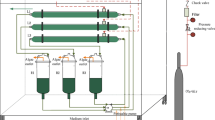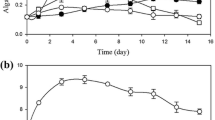Abstract
Chlorella kessleri was cultivated in artificial wastewater using diurnal illumination of 12 h light/12 h dark (L/D) cycles. The inoculum density was 105 cells/mL and the irradiance in light cycle was 45 μmol m2 s−1 at the culture surface. As a control culture, another set of flasks was cultivated under continuous illumination. Regardless of the illumination scheme, the total organic carbon (TOC) and chemical oxygen demand (COD) was reduced below 20% of the initial concentration within a day. However, cell concentration under the L/D lighting scheme was lower than that under the continuous illuminating scheme. Thus the specific removal rate of organic carbon under L/D cycles was higher than that under continuous illumination.
This result suggested thatC. kessleri grew chemoorganotrophically in the dark periods. After 3 days, nitrate was reduced to 136.5 and 154.1 mg NO3 −-N/L from 168.1 mg NO3 −-N/L under continuous illumination and under diurnal cycles, respectively. These results indicate nitrate removal efficiency under continuous light was better than that under diurnal cycles. High-density algal cultures using optimized photobioreactors with diurnal cycles will save energy and improve organic carbon sources removal.
Similar content being viewed by others
References
Faulkner, D. J. (1986) Marine natural products.Nature Prod. Rep. 3: 1–31.
Markov, S. A., P. F. Weaver, and M. Seibert (1993) Spiral tubular bioreactor for hydrogen production by photosynthetic microorganisms: Design and operation.Fuel Energy Abstracts Jan: 25.
Radmer, R. J. (1996) Algal diversity and commercial algal products.Bioscience 46: 263–270.
Borowitzka, M. A. (1999) Commercial production of microalgae: Ponds, tanks, tubes and fermenters.J. Biotechnol. 70: 313–321.
Nakajima, F., N. Kamiko, and K. Yamamoto (1997) Organic wastewater treatment without greenhouse gas emission by photosynthetic bacteria.Wat. Sci. Tech. 35: 285–291.
Nagase, H., K. Eguchi, K. Yoshihara, K. Hirara, and K. Miyamoto (1998) Improvement of microalgal NOx removal in bubble column and airlift reactors.J. Ferment. Bioeng. 86: 421–423.
Takano, H. and T. Matsunaga (1995) CO2 fixation by artificial weathering of waste concrete and coccolithophorid algae cultures.Energy Convers. Mgmt. 36: 697–700.
Hirata, S., M. Hayashitani, M. Taya, and S. Tone (1996) Carbon dioxide fixation in batch culture ofChlorella sp. using a photobioreactor with a sunlight-collection device.J. Ferment. Bioeng 81: 470–472.
Murakami, M. and M. Ikenouchi (1997) The biological CO2 fixation and utilization project by RITE (2).Energy Convers. Mgmt. 38: S493-S497.
Akimoto, M., A. Shirai, K. Ohtaguchi, and K. Koide (1998) Carbon dioxide fixation and polyunsaturated fatty acid production by the red algaPorphyridium cruentum.Appl. Biochem. Biotechnol. 73: 269–278.
Hirano, A., R. Ueda, S. Hirayama, and Y. Ogushi (1997) CO2 fixation and ethanol production with microalgal photosynthesis and intracellular anaerobic fermentation.Energy 22: 137–142.
Adamsson, M., G. Dave, L. Forsberg, and B. Cuterstam (1998) Toxicity identification evaluation of ammonia, nitrite and heavy metals at the Stensund wastewater aquaculture plant, Sweden.Wat. Sci. Technol. 38: 151–157.
Lau, R. S., N. F. Y. Tam, and Y. S. Wong (1994) Influence of organic-N sources on an algal wastewater treatment system.Resour. Conservation Recycling 11: 197–208.
Korner, S. and J. E. Vermaat (1998) The relative importance ofLemna gibba L., bacteria and algae for the nitrogen and phosphorus removal in duckweed-covered domestic wastewater.Water Res. 32: 3651–3661.
Craggs, R. J., P. J. McAuley, and V.J. Smith (1997) Waste-water nutrient removal by marine microalgae grown on a corrugated raceway.Water Res. 31: 1701–1707.
Vonshak, A. (1986) Laboratory Techniques for the Cultivation of Microalgae, pp. 117–145. In: A. Richmond (ed.),Handbook of Microalgal Mass Culture. CRC Press. Boca Raton, FL, USA.
APHA, AWWA, and WEF (1998)Standard Methods for the Examination of Water and Wastewater, 20th ed. United Book Press, Inc., Baltimore, MD, USA.
Becker, E. W. (1994)Culture Media, pp. 9–41. In:Microalgae: Biotechnology and Microbiology. Cambridge University Press, Cambridge, UK.
Oh-Hama, T. and S. Miyachi (1988)Chrorella. pp. 3–26. In: M. A. Borowitzka and L. J. Borowitzka (eds.)Microalgal Biotechnology, Cambridge University Press, Cambridge, UK.
Author information
Authors and Affiliations
Corresponding author
Rights and permissions
About this article
Cite this article
Lee, K., Lee, CG. Effect of light/dark cycles on wastewater treatments by microalgae. Biotechnol. Bioprocess Eng. 6, 194–199 (2001). https://doi.org/10.1007/BF02932550
Received:
Accepted:
Issue Date:
DOI: https://doi.org/10.1007/BF02932550




